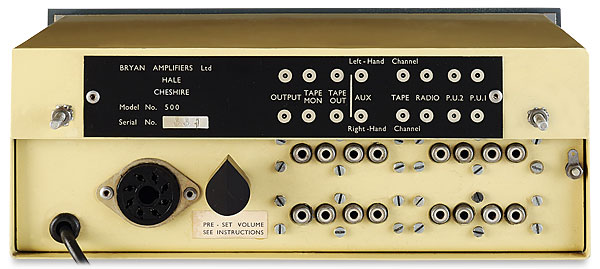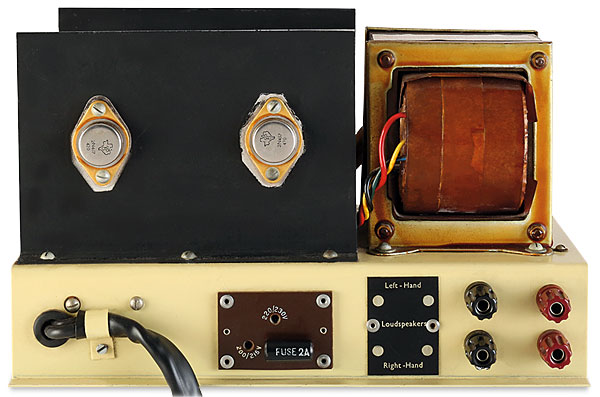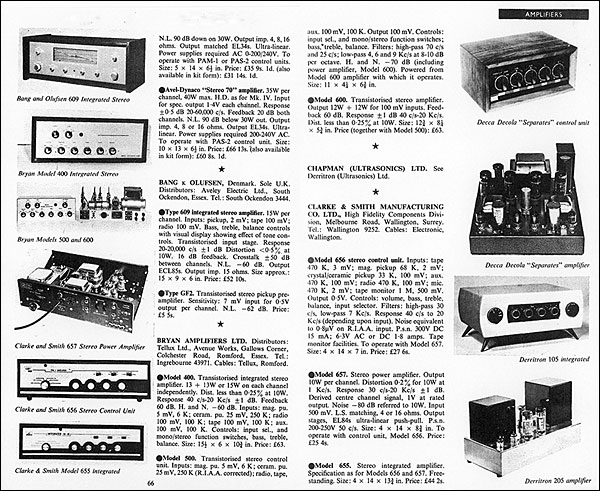Bryan Mark III Model 500/700 Pre/Power Amp Page 2

Live 'N' Dangerous
Of the various inputs available, PU2 should match any modern MM cartridge. The auxiliary group (radio, tape, aux) all suit components like CD players, though the sensitivity is a little on the high side. Bryan does provide a four-position preset volume switch on the rear panel which should help, but in practice I found that both treble and bass sounded curtailed at the lower settings. Things fill out when the higher gains are chosen, but it sounded a bit too brash on the top setting. Second from top turned out to be a workable compromise. The PU1 input was designed for ceramic cartridges and is unequalised. This would be a good place to connect an external phono stage, as long as its output level is not too high. Both units were designed for mounting in a cabinet and the Model 700 power amplifier bristles with live connections which pose an obvious hazard if the unit is used uncased. The 500 control amp, meanwhile, runs from a low voltage but still presents a potential danger because the AC mains switch wiring runs through it. So paying careful attention to the earthing arrangements is vital.
![]() Tim Listens
Tim Listens
Bryan's promotional literature declares that the 700 provides 'flawless bass' and 'superb transient reproduction', both claims due to the elimination of the output transformer. The response is also said to be substantially flat from 40Hz to 20kHz with 'no hum', so it should sound pretty good. And indeed it does – this amplifier has a surprisingly modern sound for something based on germanium technology. I don't think I ever managed to squeeze a full 13W of sound out of it without obvious distortion making its presence felt, but in the usable range below this, where it can still see off any valve amplifier based on ECL86s, ECL82s and the like, there was sufficient level for 'proper' listening.

Tonally the Bryan combo sounded balanced. I'd imagine that the designers wisely cut off the very low bass to prevent the expensive output transistors working too hard reproducing record warps, but what remains is pleasingly dry. Equally, some more modern designs can produce more treble sparkle, yet it is the avoidance of a prominent midrange that makes this a satisfying amplifier to listen to.
Being critical, the bass isn't quite 'flawless' as it has a discernible muddle in its lowest register that can cause it to bloom and give it a 'one note' quality. I was also aware of a haze present over the rest of the sound that manifested itself as a blurring of each element. This was certainly subtle, but it prevented pin-sharp focus being achieved. In these two observations I am admittedly judging the Bryan amp against the best in class performance of newer and more expensive equipment, in order to illustrate where its limitations lie. In the context of designs that were on the market at the time, it remains an impressive performer indeed.

King Crimson
Mark Knopfler's 'Madame Geneva's' from Kill To Get Crimson [Mercury 1724908] sounded suitably warm and intimate through the Bryan pairing, as befits a close-miked acoustic recording. Solid vocal centre presence made it easy to relax into the sound, which was marred only by an occasional trace of roughness around some of the guitar notes. With material like this it would be hard to ask for more from an amp. After all, there's something appealing about hearing simple recordings through well designed circuitry that isn't too complicated.
By contrast, Handel's 'Arrival Of The Queen Of Sheba' [DG/Archiv 447 279-2] was rendered in a less satisfying manner. The performance was surprisingly bright and lively, but the lack of full bass extension meant that overall the sound was on the strident side. Clarity across the orchestra was retained to an impressive degree, yet I couldn't escape from the idea that the soundstaging lacked both width and depth compared to when the piece is heard through some more capable amplifiers. It is only possible to judge the Bryan 500/700 pairing to this standard because it gets the basics so close to right – I've heard much newer amplifiers which are far less enjoyable. For this alone the duo earned my admiration. One can only speculate how far Bryan would have got with the lineage had the company lasted a few decades longer.

Buying Secondhand
Both units were solidly built and finished to a good standard. Our example was fitted with many small capacitors from Philips and these have proved to be famously durable. As such, they are best left alone.
Problems usually centre around the transistors – noise, lack of gain or silence from one channel or the other normally resolve to a transistor problem. Replacing the OC45 transistors used in the preamp with AC107s will result in improved noise performance – if you can find them. The OC35 output transistors can be replaced with slightly sturdier AD149s if these are faulty.
Hi-Fi News Verdict
A glimpse of the future wrapped in the cabinetwork of the old, I imagine the Bryan Mark III Model 500/700 would have changed the minds of many who thought transistors could never adequately replace valves. This duo is not easy to setup and use safely with no case for the Model 700, but the all-enclosed Model 3000 would make a fine choice for anyone keen to hear the sound of germanium transistors.
























































